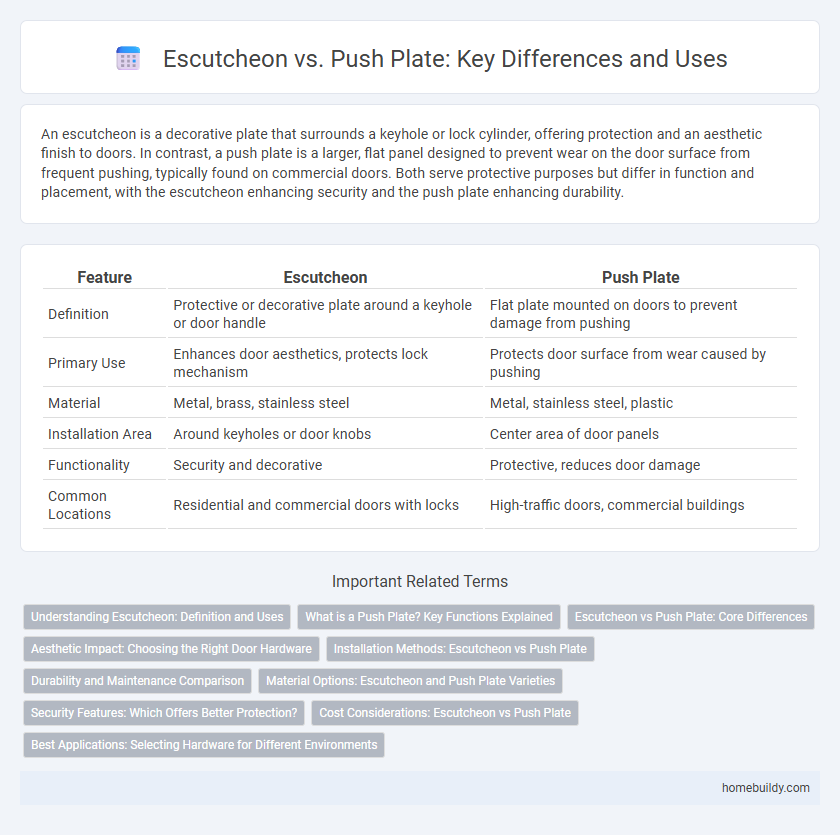An escutcheon is a decorative plate that surrounds a keyhole or lock cylinder, offering protection and an aesthetic finish to doors. In contrast, a push plate is a larger, flat panel designed to prevent wear on the door surface from frequent pushing, typically found on commercial doors. Both serve protective purposes but differ in function and placement, with the escutcheon enhancing security and the push plate enhancing durability.
Table of Comparison
| Feature | Escutcheon | Push Plate |
|---|---|---|
| Definition | Protective or decorative plate around a keyhole or door handle | Flat plate mounted on doors to prevent damage from pushing |
| Primary Use | Enhances door aesthetics, protects lock mechanism | Protects door surface from wear caused by pushing |
| Material | Metal, brass, stainless steel | Metal, stainless steel, plastic |
| Installation Area | Around keyholes or door knobs | Center area of door panels |
| Functionality | Security and decorative | Protective, reduces door damage |
| Common Locations | Residential and commercial doors with locks | High-traffic doors, commercial buildings |
Understanding Escutcheon: Definition and Uses
An escutcheon is a protective or ornamental plate surrounding a keyhole, door handle, or lock cylinder, often crafted from metal to enhance durability and aesthetics. Unlike a push plate, which is primarily designed to protect door surfaces from wear due to pushing, an escutcheon serves both functional security purposes and decorative appeal. Its use is essential in providing a neat finish to door hardware installations and can also help prevent tampering with locks.
What is a Push Plate? Key Functions Explained
A push plate is a flat, protective metal plate installed on doors to prevent wear and damage from frequent pushing. Its key functions include safeguarding door surfaces from scratches, dents, and dirt, while providing a clean, durable contact area for hands or objects. Unlike escutcheons, which primarily cover keyholes or handles for decorative and protective purposes, push plates focus on reinforcing door areas exposed to constant physical contact.
Escutcheon vs Push Plate: Core Differences
Escutcheons are decorative plates surrounding a keyhole or lock cylinder, enhancing both aesthetics and security by covering exposed hardware, whereas push plates are mounted on doors to protect the surface from wear caused by pushing. Escutcheons typically incorporate keyhole openings or accommodate door handles and locks, making them functional in access control, while push plates are flat, solid plates designed solely for contact during door operation. The core difference lies in their primary purpose: escutcheons combine decorative and security functions around locks, whereas push plates focus on durability and protection of door surfaces.
Aesthetic Impact: Choosing the Right Door Hardware
Escutcheons offer a streamlined, minimalistic appearance that enhances door hardware aesthetics by concealing lock mechanisms, while push plates provide a broader surface area that can either complement or clash with design elements depending on style and finish. The choice between escutcheon and push plate significantly influences the visual harmony of entryways, with escutcheons suited for sleek, modern designs and push plates favored in high-traffic areas requiring durability and visibility. Selecting door hardware with coordinated materials and finishes optimizes the aesthetic impact, creating cohesive and visually appealing entrances.
Installation Methods: Escutcheon vs Push Plate
Escutcheons typically require precise alignment and fixing with screws or adhesive to securely cover keyholes or lock cylinders, ensuring a flush and decorative finish on doors. Push plates install with surface-mounted screws or adhesive, often needing less precision as they protect the door from wear in high-traffic areas without concealing hardware. Both methods emphasize durability and ease of installation, but escutcheons demand meticulous positioning for optimal aesthetic and functional performance.
Durability and Maintenance Comparison
Escutcheons, typically crafted from brass or stainless steel, offer superior durability compared to push plates, which are often made from lighter materials like plastic or aluminum. Escutcheons require minimal maintenance due to their corrosion-resistant properties and ease of cleaning, making them ideal for high-traffic areas. In contrast, push plates may show wear and necessitate more frequent replacement or upkeep to maintain appearance and functionality.
Material Options: Escutcheon and Push Plate Varieties
Escutcheons are commonly made from durable metals such as brass, stainless steel, and bronze, offering corrosion resistance and aesthetic appeal in various finishes like polished, brushed, or antique. Push plates typically utilize similar materials but often prioritize stainless steel or aluminum for enhanced durability and ease of cleaning in high-traffic environments. Both escutcheons and push plates can also be found in powder-coated or plastic variants, providing versatile options for different design and functional requirements.
Security Features: Which Offers Better Protection?
Escutcheons provide enhanced security features by shielding keyholes with robust metal plates, reducing the risk of lock tampering and drilling attacks. Push plates primarily protect door surfaces from wear and damage but lack integrated security measures against unauthorized entry. Choosing an escutcheon with anti-drill and anti-pick properties offers superior protection compared to a push plate, reinforcing door security effectively.
Cost Considerations: Escutcheon vs Push Plate
Escutcheons generally cost more than push plates due to their decorative design and material quality, often crafted from brass or stainless steel for durability and aesthetic appeal. Push plates are typically more affordable, made from simpler materials like aluminum or plastic, making them ideal for high-traffic areas with budget constraints. When selecting between escutcheons and push plates, consider the balance between initial cost, long-term durability, and the desired visual impact on door hardware.
Best Applications: Selecting Hardware for Different Environments
Escutcheons provide a sleek, protective cover for door keyholes, ideal for residential and commercial settings where aesthetics and security are priorities. Push plates, designed to protect doors from wear caused by frequent pushing, are best suited for high-traffic areas such as hospitals, schools, and public buildings. Selecting between escutcheons and push plates depends on the environment's functional demands, with escutcheons enhancing locking mechanisms and push plates extending door lifespan in heavy-use scenarios.
Escutcheon vs Push Plate Infographic

 homebuildy.com
homebuildy.com